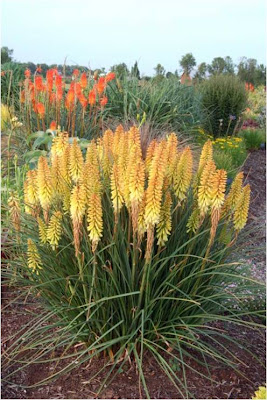For a change of pace from all the brand new and up-coming plants, here's a collection of less common, at least here in North America, plants offered by Hans Kramer's De Hessenhof nursery. This was another of my favourite stops while visiting the Netherlands.
First, is
Amsonia 'Ernst Pagels' a hybrid of
A. hubrichtii and
A. ciliata, with fine foliage that turns bright golden-yellow in the autumn, and relatively large clusters of lavender-blue flowers during the summer. Named by Rob Leopold for the esteemed German plantsman.

Next is
Dianthus gratianopolitanus 'Babi Lom', a beautiful selection from the Czech Republic with perfect mounds of steely-blue foliage, covered with electric-pink flowers in early summer. It's beautiful, but doesn't look that much different from the popular 'Firewitch'.

This (below) is
Helenium 'Baudirektor Linne', an old German variety that has performed well over the years and recently received an AGM from the trials at Wisley.
 Helenium
Helenium 'Loysder Wieck' (below) is a unique form with quilled petals, developed by Paul Wilmink, a former professor of Horticulture at Utrecht. Loysder is the ancient name for the Dutch city of Leusden.

Finally for
Helenium (yes, the Europeans love this North American native), is
H. 'Ring of Fire', another AGM recipient, with beautiful red-brown, yellow-edged flowers. Why these
Helenium, especially the award-winning varieties, are not available in North America is beyond me.

This is
Nepeta 'Blue Danube', a selection or hybrid involving
N. grandiflora, made by plantsman Christian Kress of Austria. It is a relative low form, growing to only 60cm (24"), and produces condensed clusters of purple-blue flowers for a strong impression. I like the contrast with reddish stems and calyxes.

This is
Phlox (Paniculata) 'Oljenka', apparently developed in Russia in the 1930s, with beautiful, almost tri-coloured pink, white and red, flowers. For some amazing photography of this variety, and other
Phlox (and
Helenium), check out this very cool German
website.

Finally, is
Rodgersia 'Ideal', introduced by German breeder Peter zur Linden in 1987. The emerging foliage in spring is a deep red-brown, that slowly fades to green with a darker edge by mid-summer. The pinkish flowers are produced on a tall and narrow, but heavily branched plume. Hans calls this "graceful".

Here's to dirt under your nails.
Mark, the coolplantsguy











